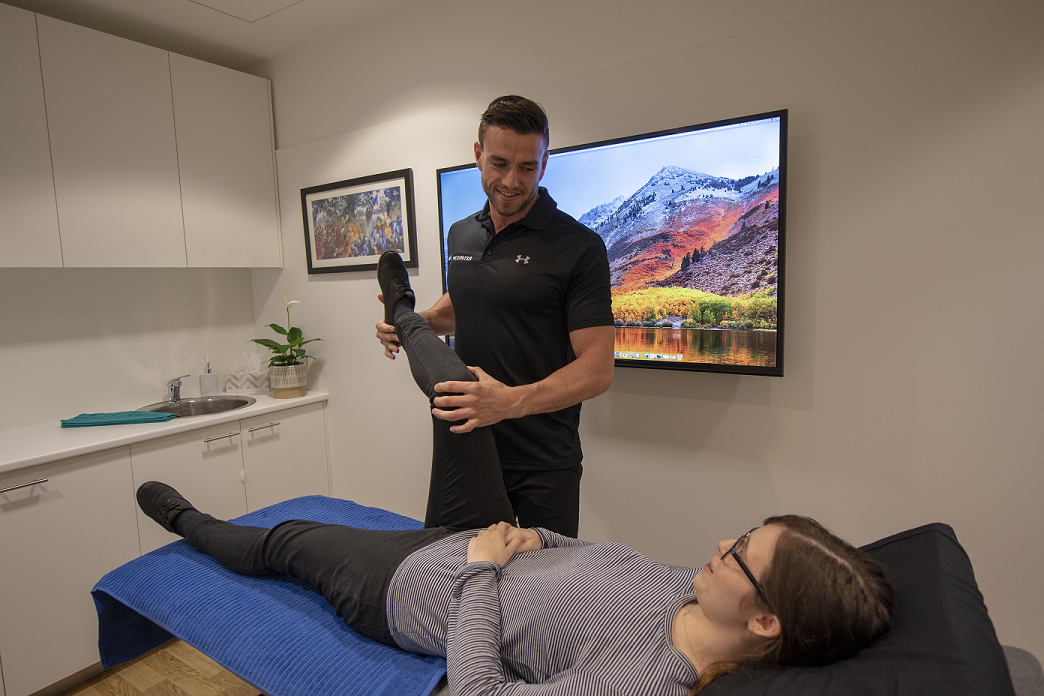What is PNF stretching technique?
What is it? How does it work? How to do it? Precautions with PNF? Featured video of technique by a physio.
What is Proprioceptive Neuromuscular Facilitation (PNF) in physiotherapy?
Proprioceptive Neuromuscular Facilitation (PNF) is a more advanced form of flexibility training. PNF involves both stretching and contracting (activation) of the muscle group being targeted in order to achieve maximum static flexibility. Physiotherapists use it to improve muscle elasticity and it has been shown to have a positive effect on active and passive range of motion (Funk et al 2003).
Actually, the term PNF stretching is itself a misnomer, but society has sort of adopted it, so let’s role with it for the moment (but just so you know it really is a technique, not a stretch).
Background
PNF was initially developed by physiotherapists as a method of rehabilitating stroke victims and refers to any of the several post-isometric relaxation stretching techniques. These are when a muscle group is passively stretched and then contracted isometrically against resistance, whilst it is in a stretched position. The technique calls for the muscle to be stretched again, passively throughout the increased range of motion gained on each repetition.
We suggest the use of a partner or your physio to provide the resistance against the isometric contraction. The person helping you can also facilitate the passive stretch through range as it is increased on each repetition. That being said, you can perform it without a partner or physio, but it tends to be more effective with the help of someone. You will see this technique being used in many clinical and non clinical settings. Ok that’s a lot so…
In a nut shell
PNF is utilised by physiotherapists to restore functional range of motion (ROM) and increase strength in patients who have sustained soft tissue damage or received invasive surgeries. It is excellent for targeting specific muscle groups, and as well as increasing flexibility. Some research also supports it improves muscular strength.
When PNF is completed prior to exercise it decreases performance in maximal effort exercises. When this stretching technique is performed consistently and post exercise, it increases athletic performance, along with range of motion.
How does it work?
Ok, this stuff gets a bit heavy. I will do my best to try and summarise this and try not to lose you along the way. If this is something that interests you, please see some the references below as this will be a verrrrrrry small summary. Also, if this doesn’t interest you, by all means skip ahead to how to perform a PNF technique, I won’t mind.
There are four theoretical physiological mechanisms contributing to PNF increasing ROM. These are autogenic inhibition, reciprocal inhibition, stress relaxation and the gate control theory.
Autogenic inhibition
Autogenic Inhibition is what occurs in a contracted or stretched muscle in the form of a decrease in the excitability because of inhibitory signals sent from the Golgi tendon organs (GTO’s) of the same muscle. It is a reflex of sudden relaxation of muscle upon development of high tension. It is a self-induced, inhibitory, negative feedback lengthening reaction that protects against muscle tear.
Reciprocal inhibition
Basically reciprocal inhibition describes the process of muscles on one side of a joint relaxing to accommodate contraction on the other side of that joint.
Stress relaxation
Stress relaxation is what occurs when the musculotendinous unit (MTU), is under a constant stress over time at a fixed length. This decreases the force generated by the viscous material when it resists the elongation stimulus that stretching causes within the MTU. Because the viscous material loses its ability to resist the stretch over time, the MTU slowly increases in length (Sharman et al, 2006).
Gate control theory
The gate control theory of pain asserts that pain signals are not free to reach the brain as soon as they are generated at the injured tissues or sites. They need to encounter certain ‘neurological gates’ at the spinal cord level and these gates determine whether the pain signals should reach the brain or not. In other words, pain is perceived when the gate gives way to the pain signals and it is less intense or not at all perceived when the gate closes for the signals to pass through. Why does someone find relief by rubbing or massaging an injured or a painful area?
How to perform a PNF technique?
PNF stretching principles has many variations and can often be referred to as different things. The two most common techniques that some of you might have heard of are: contract-relax method (CR) or hold-relax stretching and contract-relax-antagonist-contract method (CRAC).
Contract-relax method (CR)
- target muscle (TM) being lengthened (“stretched”)
- hold in stretch position while the person contracts (activates) the TM to 50-60% of maximum isometric contraction for 4-6 seconds
- follow this with a shorter relaxation of the muscle for 2-3 seconds “let go”
- during this time a passive stretch by another person assisting the technique, stretches the muscle even further than the initial passive stretch ( take further into range)
- the final passive stretch is held for 10-15 seconds
- the muscle is then relaxed for 20 seconds before performing another PNF repetition
Contract-relax-antagonist-contract method (CCRAC) method
- target muscle (TM) being lengthened (“stretched”)
- hold in position while the person contracts (activates) the agonist (TM) to about its 50-60% of maximum isometric contraction for 4-6 seconds
- straight away then activate the antagonist muscle for 4-6 seconds, defined as the muscle that opposes the action of another; “the biceps and triceps are antagonistic muscles“
- the muscles are then relaxed for 20 seconds before performing another PNF technique
PNF precautions suggested by physios
There are some precautions as physiotherapists that we suggest when performing PNF stretches. As a technique, they can put added stress on the targeted muscle group, which can increase the risk of soft tissue injury.
- during both the stretching and the contraction phase of the PNF stretch, it’s not necessary to apply maximum force or intensity.
- aim for a stretch intensity and contraction force of no more than 5-6/10 intensity or 50-60% of maximum.
- there will be a certain level of discomfort but you should feel any pain.
- the smaller the muscle group, the less force is needed. For example, if you’re stretching the small muscles around the shoulder or neck
- aim for a stretch intensity and a contraction force of 2-3/10 intensity or 20%-30% of maximum
- make sure you are warmed up before any form of stretching!
- this is essential to ensure the maximum benefit is gained. I say to my patients: “think of yourself as an elastic band that just came out of the freezer. It probably wouldn’t stretch very far yet, you need to warm that elastic band up in your hand before you go and stretch it or you may damage the integrity of the rubber band”. Same principle to apply to your muscles, tendons and fascia
- keep breathing, very important in physiotherapy
- when you relax, breathe out and really “let go”, sink into the stretch and see the range increase between 10-40 degrees.
- you must communicate with your physiotherapist or partner!
- they should not apply an excessive force to your muscles, joints that is above 5-6/10. You need to communicate if you are feeling anything more than this. You are allowed to tap out!
Please click above on our featured video of a PNF stretch technique for the hamstring, being performed by one of our physiotherapists.
In this blog are just some guidelines and information that we as physio’s find useful and interesting. We ALWAYS recommend patients have a thorough physical assessment with a professional when starting out with any new exercises or management plan. Call us on 0284019320 and make your physiotherapy appointment today.
References
Etnyre, B. et al. (1988) Chronic and Acute Flexibility of Men and Women Using Three Different Stretching Techniques. Research Quarterly for Exercise and Sport, Volume 59, Issue 3, Pages 222-228
Funk DC, Swank AM, Mikla BM, Fagen TA, Farr BK. Impact of Prior Exercise on Hamstring Flexibility: A Comparison of Proprioceptive Neuromuscular Facilitation and Static Stretching. Natl Str Cond Assoc J. 2003;17(3):489–492
Kayla B. Hindle, Tyler J. Whitcomb, Wyatt O. Briggs, Junggi Hong, J Hum Kinet. 2012 Mar; 31: 105–113. Proprioceptive Neuromuscular Facilitation (PNF): Its Mechanisms and Effects on Range of Motion and Muscular Function. Published online 2012 Apr 3. doi: 10.2478/v10078-012-0011-y
Sharman, MJ. et al. (2006) Proprioceptive neuromuscular facilitation stretching: mechanisms and clinical implications. Sports Medicine, 36(11):929-39.
Yutetsu, M. et al. (2013) Effects of Proprioceptive Neuromuscular Facilitation Stretching and Static Stretching on Maximal Voluntary Contraction. Journal of Strength and Conditioning Research, Volume 27 – Issue 1 – p 195–201.


Sorry, comments are closed for this post.